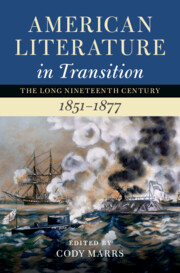Book contents
- American Literature in Transition, 1851–1877
- Nineteenth-Century American Literature in Transition
- American Literature in Transition, 1851–1877
- Copyright page
- Contents
- Figures
- Contributors
- Series Preface
- Introduction
- Part I Careers
- Part II Networks
- Part III Exchanges
- Part IV The Long Civil War
- Chapter 17 The Coming Civil War
- Chapter 18 Union Literature
- Chapter 19 Confederate Literature
- Chapter 20 Reconstruction Literature
- Chapter 21 The Global Civil War
- Index
Chapter 17 - The Coming Civil War
from Part IV - The Long Civil War
Published online by Cambridge University Press: 15 June 2022
- American Literature in Transition, 1851–1877
- Nineteenth-Century American Literature in Transition
- American Literature in Transition, 1851–1877
- Copyright page
- Contents
- Figures
- Contributors
- Series Preface
- Introduction
- Part I Careers
- Part II Networks
- Part III Exchanges
- Part IV The Long Civil War
- Chapter 17 The Coming Civil War
- Chapter 18 Union Literature
- Chapter 19 Confederate Literature
- Chapter 20 Reconstruction Literature
- Chapter 21 The Global Civil War
- Index
Summary
Armies prepare to fight the last war, or so the adage goes. Napoleon, for instance, won great battles attacking with tight formations of troops, and mid-nineteenth-century military leaders emulated his tactics, even as advances in bullet and rifle technology rendered them increasingly ineffective. This became brutally apparent in the American Civil War as defenders capable of shooting more quickly and accurately at longer distances decimated charging formations. The problem of predicting the nature of future wars by looking to past conflicts can be more generally summed by another adage, this one traceable to Søren Kierkegaard in 1843: life can only be understood backward, but it must be lived forward.1
Keywords
- Type
- Chapter
- Information
- American Literature in Transition, 1851–1877 , pp. 273 - 288Publisher: Cambridge University PressPrint publication year: 2022

